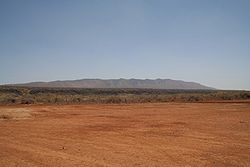Rift Valley Province: Difference between revisions
Omnipaedista (talk | contribs) punctuation |
Reaverdrop (talk | contribs) m fix rd |
||
| Line 48: | Line 48: | ||
}} |
}} |
||
'''Rift Valley Province''' of [[Kenya]], bordering [[Uganda]], is one of Kenya's seven administrative [[Provinces of Kenya|provinces]] outside [[Nairobi]]. |
'''Rift Valley Province''' of [[Kenya]], bordering [[Uganda]], is one of Kenya's seven administrative [[Provinces of Kenya|provinces]] outside [[Nairobi]]. |
||
Rift Valley Province is the largest and one of the most economically important provinces in [[Kenya]]. It is dominated by the [[Kenya Rift Valley]] which passes through it and gives the province its name. According to the 1999 Census, the province covers an area of {{convert|173854|km2|acre sqmi}} and has a population of 8,786,300 inhabitants (2007),{{citation needed|date=January 2010}} making it the largest and most populous province in the country. The capital is the town of [[Nakuru]]. |
Rift Valley Province is the largest and one of the most economically important provinces in [[Kenya]]. It is dominated by the [[Great Rift Valley, Kenya|Kenya Rift Valley]] which passes through it and gives the province its name. According to the 1999 Census, the province covers an area of {{convert|173854|km2|acre sqmi}} and has a population of 8,786,300 inhabitants (2007),{{citation needed|date=January 2010}} making it the largest and most populous province in the country. The capital is the town of [[Nakuru]]. |
||
== Geography == |
== Geography == |
||
Revision as of 01:09, 13 August 2012
This article needs additional citations for verification. (August 2007) |
Rift Valley Province | |
|---|---|
 Rift Valley | |
 Location in Kenya. | |
| Country | |
| No. of districts: | 36 |
| Capital | Nakuru |
| Area | |
| • Total | 182,413 km2 (70,430 sq mi) |
| Population (2009) | |
| • Total | 10,006,805 |
| • Density | 55/km2 (140/sq mi) |
| Time zone | UTC+3 (EAT) |
Rift Valley Province of Kenya, bordering Uganda, is one of Kenya's seven administrative provinces outside Nairobi. Rift Valley Province is the largest and one of the most economically important provinces in Kenya. It is dominated by the Kenya Rift Valley which passes through it and gives the province its name. According to the 1999 Census, the province covers an area of 173,854 square kilometres (42,960,000 acres; 67,125 sq mi) and has a population of 8,786,300 inhabitants (2007),[citation needed] making it the largest and most populous province in the country. The capital is the town of Nakuru.
Geography

The Great Rift Valley runs south through Kenya from Lake Turkana in the north and has several unique geographical features, including the Elgeyo escarpment which is a popular tourist attraction.
Apart from the Rift Valley itself, the area has other important geographic features such as: the extinct volcanoes Mount Longonot and Mount Suswa and Lake Baringo, Lake Bogoria, Lake Magadi, Lake Nakuru, Lake Naivasha, the Suguta Valley, and Lake Turkana.
Geology
A large part of Kenya is underlain by Precambrian basement, while the Kenya rift basin (a typical extensional basin) hosts Tertiary volcanics that cover Mesozoic sediments (Recently these sediments have been considered for oil exploration).[1] The sedimentary basins evolved along the Anza trough during the Late Paleozoic to Early Tertiary times through extension tectonics during the major Gondwanaland breakup. In the Miocene Period the region underwent intermittent uplift and subsidence along major boundary faults accompanied by the large outpouring of lava flows. The Anza trough intersects the modern rift valley in the area of Lake Turkana. Rifting still continues today; primarily in the north, where active volcanoes are more plentiful.
Economy
The highlands provide adequate rainfall for farming and agriculture which is the economic base of the residents of the Rift Valley. Tea from the highlands in the Kericho district enjoy a world wide reputation, but horticulture is an important part of the district's economy and cattle raising is also practised to a large extent.
The full economic potential of the Rift Valley region is, however, far from fully exploited, though the current growth in population and improved education may change this in a near future. People in the province are still mostly rural, but urbanisation is gradually increasing; new cities and towns contain the rural-urban migration and, provided the right policies are instituted, the Rift Valley province will be able to emerge as a national economic and cultural hub.
Ethnicity
The people of the Rift Valley are a mesh work of different tribal identities, and the Kalenjin and the Maasai are two of the best known ethnic groups. Most of Kenya's top runners comes from the Kalenjin community. The Maasai people have the most recognizable cultural identity, both nationally and internationally, and serve as Kenya's international cultural symbol.
Districts
District (capital):
Baringo (Kabarnet) ·
Bomet (Bomet) ·
Buret (Litein) ·
Kajiado (Kajiado) ·
Keiyo (Iten / Tambach) ·
Kericho (Kericho) ·
Koibatek (Eldama Ravine) ·
Laikipia (Nanyuki) ·
Marakwet Kapsowar) ·
Nakuru (Nakuru) ·
Nandi (Kapsabet) ·
Narok (Narok) ·
Samburu (Maralal) ·
Trans Mara (Kilgoris) ·
Trans-Nzoia (Kitale) ·
Turkana (Lodwar) ·
Uasin Gishu (Eldoret) ·
West Pokot (Kapenguria)
Districts after 2007
Several new districts have been created since 2007 in Kenya, also in Rift Valley Province [2]:
See also
References
Following the national referendum held on August 4, 2010, a new structure of governance which in effect banned existing provinces was introduced. In the place of provinces, 47 counties were created.[citation needed]
